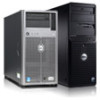Dell PowerEdge M520 Technical Guide - Page 28
Acoustical performance
 |
View all Dell PowerEdge M520 manuals
Add to My Manuals
Save this manual to your list of manuals |
Page 28 highlights
Environmental specifications: The optimized thermal management makes the PowerEdge M520 reliable under a wide range of operating environments as shown in Table 23. When operating above 30°C ambient, performance impacts may be seen. For more information see the Dell PowerEdge M520 Systems Owner's Manual on Dell.com/Support/Manuals. Acoustical performance The acoustical performance of the PowerEdge M520 is reflected in Table 15. The addition of some components can cause an increase in fan speed and acoustical output. Contributors to acoustical output can include: The system thermal profile selected in BIOS (for example, power- or performance- optimized DAPC) Number of installed processors Population of modular, non-homogenous modular deployment Impedance of blanks Table 15. M520 acoustical performance Configuration (23 ± 2°C CPUs ambient) Hard drives DIMMs HDD controller NDC PCI cards Operating mode LWA-UL1 (bels) LpA2 (dBA) Minimum 1 x 80W (4 core) 1 x SATA (7.2K) 4 x 2GB Onboard SATA Any None mezzanine card Standby3 Idle4 6.7 7.2 53 56 Typical 2 x 95W 2 x SAS (8 core) (10K) 8 x 4GB PERC H310 (mini) Any 1Gb mezzanine card Standby3 Idle4 6.8 7.2 53 56 1LWA-UL is the upper limit sound power levels (LWA) calculated per section 4.4.1 of ISO 9296 (1988) and measured in accordance to ISO 7779 (2010). 2LpA is the averaged A-weighted sound pressure level of four bystanders in accordance with ISO 7779 (2010) Section 8.6.2. The system is placed inside 42U rack in 25 cm height. 3Standby: AC power is connected to power supply units but the system is not turned on. 4Idle: Reference ISO 7779 (2010) definition 3.1.7; system is running in its operating system but no other specific activity. 28 PowerEdge M520 Technical Guide















